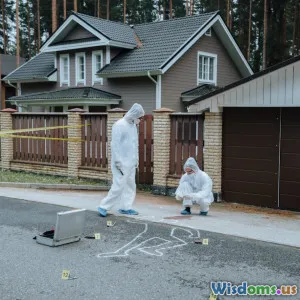
Challenges in Urban Crime Investigations
8 min read Explore the multifaceted challenges in urban crime investigations and effective strategies to overcome them. (0 Reviews)
Challenges in Urban Crime Investigations
Urban areas are dynamic, dense, and complex ecosystems that embody the heartbeat of modern civilization. Yet, beneath their vibrancy, cities often grapple with high rates of crime, creating daunting investigative environments for criminologists and law enforcement agencies. Investigating crime in these urban hubs involves hurdles far beyond the traditional investigative scope because of diverse social, technological, and infrastructural factors intertwined within the city fabric.
In this article, we will dissect the multifaceted challenges inherent in urban crime investigations, backed by concrete examples and empirical insights, and articulate practical strategies that can help mitigate these obstacles.
Understanding the Urban Crime Landscape
The urban crime investigation journey begins with understanding its unique setting. Cities are typically characterized by high population density, social heterogeneity, and technological integration, each contributing differently to the criminal ecosystem.
For example, New York City’s crime has sharply declined over the last few decades, yet the diversity in neighborhoods—from densely crowded Manhattan to expansive outer boroughs—poses varied investigative difficulties. Urban crime can range from street-level offenses such as vandalism and robbery to complex cybercrimes and organized crime syndicates that thrive in metropolitan anonymity.
Major Challenges in Urban Crime Investigations
1. High Population Density and Anonymity
One of the foremost challenges in urban environments is dealing with crowded settings where anonymity is both a natural shield for perpetrators and an obstacle for investigators. According to the U.S. Department of Justice, high population density complicates eyewitness identifications because of the volume of bystanders or the fast-paced nature of urban life.
In cities like Mumbai or São Paulo, the sheer number of people available as witnesses or suspects can overwhelm investigative resources, creating bottlenecks in processing and interrogation.
2. Technological Complexities and Cybercrime
Urban centers are hubs for technology, with high internet penetration and digital device usage, leading to an increased incidence of cybercrimes like identity theft, hacking, and online fraud. Investigating these crimes requires specialized knowledge in digital forensics.
For instance, the 2018 Atlanta ransomware attack disrupted city services and required collaboration between the police and cybersecurity experts. Many law enforcement officers often lack sufficient training or resources to tackle technologically sophisticated crimes, which prolongs investigations.
3. Fragmented Communication and Data Silos
Urban crime investigations frequently suffer due to fragmented communication channels among various law enforcement bodies and jurisdictions. Cities often host multiple agencies (local police, transit police, federal investigators), each maintaining separate data systems.
This fragmentation leads to data silos. A study by the Police Executive Research Forum (PERF) highlights that inadequate data sharing impairs investigators’ ability to develop comprehensive criminal profiles or spot patterns critical for solving crimes—a severe disadvantage in time-sensitive cases.
4. Social and Cultural Diversity
Cities attract a diverse population along ethnic, linguistic, and socioeconomic lines. This vibrant melting pot also injects barriers, such as language differences and cultural distrust of authorities, which can hinder community cooperation in investigations.
For example, in London, police forces work with various immigrant communities who may fear deportation or discrimination, thereby resisting cooperation. Building trust and culturally sensitive approaches is crucial but challenging.
5. Resource Constraints and Overburdened Systems
Despite being urban centers with significant budgets, many police departments face resource shortages due to increasing crime complexity and population growth. High caseload volumes, limited forensic labs, and insufficient staffing contribute to delayed or unresolved investigations.
The backlog of unsolved cases known as cold cases is a testament to overburdened systems. For instance, Chicago has thousands of murders with investigations that remain stagnant because of insufficient manpower.
Strategies to Overcome Urban Investigation Challenges
Investing in Technology and Training
To combat technological challenges, continuous training in digital forensics and the deployment of advanced investigative tools—such as AI-powered surveillance, data analytics, and real-time crime centers—are critical.
Cities like Los Angeles have embraced predictive policing models that utilize big data to anticipate crimes and deploy resources more strategically. However, ethical considerations must be carefully managed to avoid bias.
Enhancing Interagency Collaboration and Information Sharing
Creating integrated communication frameworks helps break down data silos. The use of centralized databases, joint task forces, and interoperability platforms enhances coordination between agencies.
New York’s Real Time Crime Center exemplifies this strategy by aggregating data streams to support field officers instantaneously with actionable intelligence.
Community Policing and Building Trust
Fostering community trust improves information flow and eyewitness cooperation. Training officers in cultural competency and establishing liaison programs in neighborhoods encourages reporting and reduces the culture of silence.
An example is the ‘Neighborhood Liaison Officers’ program in Toronto which builds bridges with diverse communities, leading to better crime tips and support.
Prioritizing Resources and Cold Case Units
Allocating dedicated personnel to cold cases or complex investigations ensures ongoing attention and the application of fresh perspectives and technologies such as DNA re-analysis.
For example, the London Metropolitan Police Cold Case Review Unit has successfully reopened decades-old investigations with modern forensic techniques.
Conclusion
Urban crime investigations are undeniably complex, saddled with unique challenges that span population density, technological evolution, social diversity, and institutional limitations. The dynamic environment of cities demands progressive, multifaceted approaches—from embracing technology and inter-agency coordination to community engagement and specialized resources.
For those involved in criminology and law enforcement, recognizing these challenges is only the beginning. The imperative lies in adapting investigation strategies effectively, fostering trust within diverse urban populations, and continuously investing in skills and technology. Through such committed efforts, the daunting obstacles of urban crime investigation can transform into opportunities for safer, more resilient cities.
“In the complexity of our cities lie the solutions to our toughest crimes—if only we can see and seize them.”
References:
- U.S. Department of Justice Crime Data: https://www.bjs.gov
- Police Executive Research Forum (PERF) reports on data sharing
- Case study: Atlanta ransomware attack (2018)
- London Metropolitan Police Cold Case Unit https://www.met.police.uk
- Los Angeles Real Time Crime Center overview
Rate the Post
User Reviews
Popular Posts

















